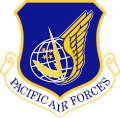512th Rescue Squadron  | |
|---|---|
 HH-60 Pave Hawk as flown by the squadron | |
| Active | 1942–1946; 1947–1948; 1949–1951; 1951–1965; 1994–present |
| Country | |
| Branch | |
| Role | Search and rescue training |
| Part of | Air Education and Training Command |
| Garrison/HQ | Kirtland Air Force Base |
| Engagements | Mediterranean Theater of Operations Korean War |
| Decorations | Distinguished Unit Citation Air Force Outstanding Unit Award |
| Insignia | |
| 512th Rescue Squadron emblem [a] [1] |  |
| 512th Bombardment Squadron emblem [b] [2] |  |
The 512th Rescue Squadron is part of the 58th Special Operations Wing based at Kirtland Air Force Base, New Mexico. It formerly operated the Bell UH-1N Twin Huey and currently operates the Sikorsky HH-60G Pave Hawk and the new HH-60W Jolly Green II helicopters training aircrew conducting search and rescue missions.
Contents
- Mission
- History
- World War II
- Weather reconnaissance
- Strategic Air Command
- Helicopter training
- Lineage
- Assignments
- Stations
- Aircraft
- Awards and campaigns
- See also
- References
- Notes
- Bibliography
The squadron was formed during World War II as the 512th Bombardment Squadron in the Middle East in 1942 to reinforce the Royal Air Force in North Africa with personnel and aircraft diverted from delivery to the China Burma India Theater. The squadron moved forward, eventually being stationed in Italy, where it participated in the strategic bombing campaign against Germany, and was awarded three Distinguished Unit Citations for its combat actions. Following V-E Day, the squadron returned to the United States, where it converted to Boeing B-29 Superfortress bombers, but was inactivated in March 1946.
The squadron was redesignated the 512th Reconnaissance Squadron and activated in 1947 as a weather reconnaissance unit. Except for a brief period of inactivation in the winter of 1948–1949, it continued the reconnaissance mission until February 1951, when it was inactivated and its assets transferred to another squadron.
The squadron returned to the bombardment mission later that year, and upgraded to jet Boeing B-47 Stratojet bombers in 1954. It continued to fly the Stratojet until they were phased out of the Air Force inventory, and the squadron was inactivated in 1965.
The squadron was activated as the 512th Special Operations Squadron in April 1994 and assumed its mission of training helicopter aircrews.









